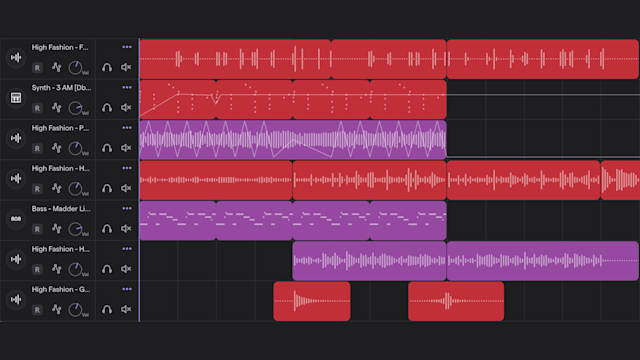How To Create a Good Song Structure - Parts of a Song Explained
August 18, 2023 / Anton Berner

One of the most important skills a songwriter or music producer needs to have is the ability to structure a song in a way that’s compelling to the audience. Songs, more specifically great songs, are not just pieced together randomly. A solid song structure helps to build suspense, interest, and recognition in music.
Let’s take the hit song “Blinding Lights” by The Weeknd as an example, the most successful song in the 21st century. The song is produced by legendary Swedish hitmaker Max Martin, who didn’t hold back on any of his musical chops to put together this synth-pop masterpiece.
“Blinding Lights” contains a very elaborate and thought-out song structure to maximize the effect the song has on the audience. It starts out with a suspenseful song intro that teases the top melody before the beat drops and plays its way to the first verse where The Weekends vocals first come in.
The verse transitions into the chorus through a pre-chorus build-up to maximize the climax of the song when the chorus begins. Martin then chose to have instrumental break bridges between the chorus and the next verse, so that listeners can just enjoy the dance-friendly music before the lyrics come back in. We get another bridge between the last two choruses to give the audience one last climactic experience before the song beautifully sails into the outro.
All these song parts together make up the brilliance that is “Blinding Lights”. Below, we will go through each part and explain how they can help you create better songs and connect with a wider audience.
Song structure 101: Song parts explained
Intro
The intro is the initial segment of a song that captures the listener's attention and sets the mood for what's to come. It's usually a short passage that introduces some of the musical and thematic elements of the song. Intros can vary widely in style and complexity, ranging from a simple instrumental melody to a more elaborate arrangement.
A truly powerful intro can make the listener’s ears perk up and decide to stick around for the rest of the song. Listen to Journey’s “Don’t Stop Believin’” to get a sense of how an intro can instantly grab a listener with a simple piano melody.
Verse
The verse in a song is a core component of the song's narrative, where the lyrics tell a part of the story or convey emotions. It's typically repeated multiple times throughout the song, in between the chorus, each time with different lyrics to advance the storyline or explore different aspects of the theme. Verses often have a relatively lower energy level compared to the chorus, allowing the lyrics to take center stage and unfold the song's message.
Pre-Chorus
The pre-chorus acts as a bridge between the verse and the chorus. It usually comes after each verse and serves to build anticipation and tension, preparing the listener for the upcoming chorus. Musically, the pre-chorus typically has a slight lift in energy and melody, while lyrically, it might introduce a new perspective or emotion that connects the verse and chorus thematically. It's a transitional section that heightens the emotional impact of the chorus. “Smells Like Teen Spirit” by Nirvana is a great example of how to use a pre-chorus to build up suspense before the actual chorus.
Chorus
The chorus is one of the most recognizable and memorable parts of a song. If you hear the words “I Wanna Dance with Somebody”, you will probably instantly start singing the rest of the chorus of Whitney Houston’s timeless 1987 hit song. This is the power of a great chorus.
A good chorus usually contains the song's title and main message, presented in a catchy and repetitive manner — called a hook. The chorus is the emotional and musical peak of the song, characterized by a higher energy level, strong instrumentation, and a melodic hook that sticks in the listener's mind. Its repetition makes it easy for listeners to sing along and provides a central focal point for the song's theme or message.
Bridge
The bridge in a song offers a contrast to the rest of the music, providing a departure from the verse-chorus (ABAB) structure. It often appears after the second or third chorus and serves to introduce a new element, such as a different melody, chord progression, or lyrical theme.
The bridge can also add depth to the song by offering a fresh perspective, resolving tension, or introducing an unexpected twist. It acts as a dynamic shift that keeps the listener engaged and prevents the song from becoming too repetitive. Kate Bush beautifully does this on her revived 80’s smash “Running Up That Hill” after the second chorus.
Outro
The outro, also known as the coda, is the final segment of the song that brings it to a close. It's a conclusion that can be a repetition of the chorus or a completely new musical idea. The outro provides a sense of resolution and closure to the listener, allowing the song to gradually fade out or end with a powerful musical statement. In today’s music, shorter outros are more common, like an abrupt sound drop or a quick instrumental fade out. Check out the outro to Eric Clapton’s “Laila” to get a sense of how to finish a song by slowing down the music and lyrics during the last few seconds of the song.
So, are you ready to start making hits? These song parts and structure pieces, when combined effectively, create a balanced and engaging musical journey that captures the listener's attention, conveys emotions, and delivers a memorable experience. How you piece them together is up to you, but we’ll give you some ideas on popular song structures below.

A solid song structure helps to build suspense, interest, and recognition in music.
Chorus vs. Hook vs. Refrain
As a sidenote, let’s clear up the confusion around song structure terminology because these words are often used interchangeably when referring to a song’s chorus.
In songwriting, the chorus stands out as the recurring segment that carries the song's main theme and emotional core. It's musically and lyrically impactful, creating a central point for listeners to connect with.
The hook, on the other hand, is the catchy and memorable element that grabs attention and lingers in the mind. While it can be part of the chorus, it can also appear in other song sections. A hook can be a catchy line of lyrics, a beat drop, a top melody, or a certain sound that makes the listener remember the song.
Additionally, the refrain is a repeated phrase or line that reinforces the song's message, often found at the end of verses or choruses. Thing “She Loves You” by the Beatles or the “Whoo hoo” in Blur’s “Song 2”.
These components collectively shape the structure and impact of a song, offering distinct ways to engage and resonate with the audience.
Song structures for different types of music genres
Song structures can vary significantly across different music genres, as each genre has its own conventions and traditions. Here's a brief overview of how song structures differ in various music genres:
Pop
Pop music often relies on a straightforward and catchy song structure. It commonly follows the verse-chorus-verse-chorus-bridge-chorus pattern. The emphasis is on memorable melodies and relatable lyrics, with the chorus being a focal point. Pop songs typically have a strong hook that serves as the centerpiece of the song.
Rock
Rock music can have diverse song structures, but many rock songs follow a pattern similar to pop, with variations. They often feature a verse-chorus structure, but with more emphasis on instrumental solos and breakdowns. Rock songs may also incorporate longer instrumental sections, allowing for extended guitar solos or dynamic shifts in energy.
Hip-Hop/Rap
Hip-hop and rap often prioritize rhythmic patterns and lyrical storytelling. Song structures in these genres usually include verses and hooks, but with some songs skipping traditional choruses and build verses on verses. The focus in Hip Hop and Rap is on the flow and rhythm of the lyrics, and the beat often serves as a defining element. Frequent use of samples and loops can create a unique structure in Hip Hop with samples or instruments dropping in and out to diversify the structure.
Electronic/Dance
Electronic and dance genres often prioritize repetitive and evolving musical patterns. These songs can have an intro that gradually builds energy, followed by multiple instrumental sections with climactic drops. The structure may involve build-ups, breakdowns, and drops, creating a dynamic and continuous flow of energy for dancing.

Soundtrap allows you to organize your project into song parts.
What is strophic form in music?
The strophic form is a specific song structure where the same melody is repeated for each verse of lyrics. It’s also the most utilized structure in electronic music like Hip Hop, EDM, Dance, Pop, etc.
In this form, the music remains consistent while the lyrics change with each verse, allowing for the narrative or thematic content to unfold in a straightforward manner. Strophic songs focus on the repetitiveness of the melody, making them easy to sing along to and creating a sense of familiarity for the listener.
Strophic form's simplicity has made it a popular choice across various musical traditions, emphasizing the importance of the lyrics and enabling audience participation. However, not all songs adhere to this structure, as some opt for more complex forms or mix different structures to create varying musical experiences. Just take a listen to “Bohemian Rapsody” by Queen and you will find that popular music doesn’t need to adhere to classic forms and structures.
What is through-composed form in music?
Through-composed form in music refers to a structure where each section of a song features unique music, without repeating complete sections. Unlike more repetitive forms, through-composed songs evolve with the lyrics and emotions, offering a dynamic and progressive musical experience that suits storytelling and diverse themes. This approach is often used in art songs, musical theater, and experimental music, allowing for intricate musical storytelling and flexibility in adapting to the lyrical content.
Common song structures in popular music
ABAB song form
The ABAB song form, also known as "verse-refrain-verse-refrain" or "verse-chorus-verse-chorus," is a common song structure used in many genres of music. In this form, the song alternates between two main sections: the A section (usually a verse) and the B section (typically a refrain or chorus).
A Section (Verse): The A section is the main body of the song's narrative or message. It often introduces new lyrics that advance the story or theme. Musically, the A section might have a more subdued or introspective quality compared to the B section.
B Section (Refrain/Chorus): The B section serves as a contrasting counterpart to the A section. It typically contains the song's main hook, catchiest melody, and often the central message. The B section is usually more musically dynamic and emotionally intense than the A section, drawing the listener's attention and leaving a lasting impression.
The ABAB song form alternates between these two sections, creating a sense of contrast and repetition. This structure allows for the development of a storyline or theme through the verses while maintaining a memorable and impactful refrain or chorus that listeners can easily connect with. It's a versatile form that accommodates various musical genres and is particularly well-suited for songs with a strong lyrical focus and a catchy hook.
AABA song form
The AABA song form is a classic structure used in songwriting, particularly in popular music and jazz standards. It consists of four main sections: two A sections, a B section, and another A section. Each of these sections typically corresponds to a specific musical or lyrical theme.
A Section (Verse): The first A-section is the initial presentation of the main theme or melody. It sets the tone and introduces the song's narrative or message. The melody and lyrics are often repeated in the second A section for consistency.
B Section (Bridge): The B section, also known as the bridge, offers a contrast to the A sections. It might have a different melody, chord progression, and lyrical content. The bridge serves as a departure from the main theme and adds variety to the song.
A Section (Verse): The third section returns to the familiar A theme, repeating the melody and lyrics from the beginning. This repetition provides a sense of resolution and brings the song full circle.
The AABA form is known for its balance and its ability to tell a story or convey a message within its structured framework. While there can be variations and extensions within each section, the overall structure remains consistent. This form has been used in a wide range of musical genres, and it allows for the development of themes and variations while maintaining a sense of familiarity for the listener.
How long should a verse and chorus be?
Again, there are no rules here. After all, music is art and can be performed in any way possible. With that being said, there are some common threads in music when it comes to the length of song parts
Verse: A verse usually has 4 to 16 lines, or bars, with one bar containing 4 beats (think kick, snare, kick snare). A verse usually lasts for 15 to 45 seconds, conveying narrative details and transitioning to other sections.
Chorus: A chorus is usually shorter than the verse, and involves a catchy segment. The length of a chorus is dependent on the length of the verse. If you have an 8-bar verse, a 4-bar chorus probably makes the most sense. It’s also common to repeat the last chorus twice, so the 4-bar chorus turns into a repeated 8-bar chorus.
We hope that you have a better understanding of song parts and song structure after having read this article. We want to stress once again that music is subjective and rules are supposed to be broken. That is how great music is made. But if you’re just starting out as a songwriter, some guidance is usually helpful to get the ball rolling. Don’t forget to share this article with your fellow music makers and let us know when you’ve released your first song, we’d love to hear it!
Get better song structure with Soundtrap
Did you know that the Soundtrap Studio has a song parts functionality that lets you build out your song structure in an organized way by tagging up your song sections with corresponding parts? Easily tag up your intro, verse, chorus, and more, and make sure that you have a clear overview of your project. Try out Soundtrap for free today!
About the author
Anton Berner is a music producer, audio engineer, and songwriter from Stockholm, Sweden. He's produced hip-hop & rap music since the early 2000s and his expertise is in vocal mixing and sample-based beat production. Anton is also the SEO & Content Manager @ Soundtrap and manages the blog and newsroom.
Get started with Soundtrap today!